Learn about the Banff Springs Snail—an endangered species that is only found in the thermal springs in Banff National Park. Many thanks to Dr. Dwayne Lepitzki for putting this great resource together and sharing it with BVN. If you are interested in sharing nature-related resources, please contact us.
Table Of Contents
INTRODUCTION

Near the town of Banff in Banff National Park, Alberta, Canada lives a little snail that is found nowhere else in the world. According to COSEWIC (Committee on the Status of Endangered Wildlife in Canada) and until the spring of 2010, it was the only species in Banff – Canada’s first national park – that was Endangered. This means that of all the plants and animals that live in Banff, it was the species most at-risk of going extinct.
However, in April 2010, COSEWIC also assessed the Whitebark Pine (Pinus albicaulis) as Endangered. This is a tree that is confined to high elevations in the mountains of British Columbia and Alberta, including Banff.
A research and recovery program on the snail, its habitat, and threats has been ongoing since the fall of 1995. While the program has been funded in large part by Banff National Park, other contributors have included the Parks Canada Species at Risk Recovery Action and Education Fund, the Hot Springs Enterprise Unit of Parks Canada, the Endangered Species Recovery Fund (sponsored by the World Wildlife Fund – Canada, Canadian Wildlife Service, and the Canadian Millennium Partnership Program), and the Bow Valley Naturalists.
Why is the snail here? Why is it important? Why should you care? This is a summary of what’s been learned and how you can help. We’ll explore the life of the snail as well as its fascinating habitat. This was written by the Principal Investigator, Dr. Dwayne A.W. Lepitzki, who has been on contract with Parks Canada since the fall of 1995 to study the Banff Springs Snail. Unless otherwise noted, all text, photos, graphs, and models are copyrighted by D.A.W. Lepitzki. He can be contacted through this BVN website.
Funding to help develop these webpage summaries was provided by a donor to BVN who wanted to help spread the word about the little snail.
HISTORY & GEOLOGY
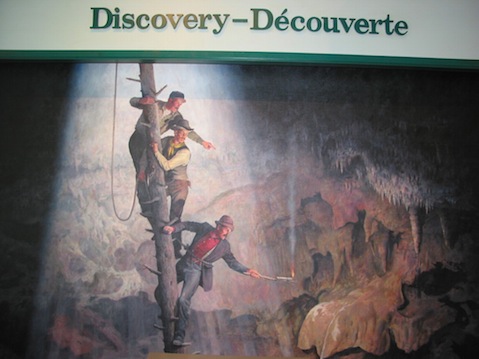
Some people suggest that the history of the Cave and Basin National Historic Site, the birthplace of Canada’s system of national parks, began with the discovery of the springs by three railway workers in the fall of 1883. Other people say the history of the area began with the First Nations people. Archaeological digs near the Town of Banff suggest that people have been using the area since the glaciers left, 10,000 to 12,000 years ago.
However, the history of the area extends much further back in time. Scientists indicate that the Rocky Mountains began forming 140 million years ago with the building period coming to a close about 45 million years ago.
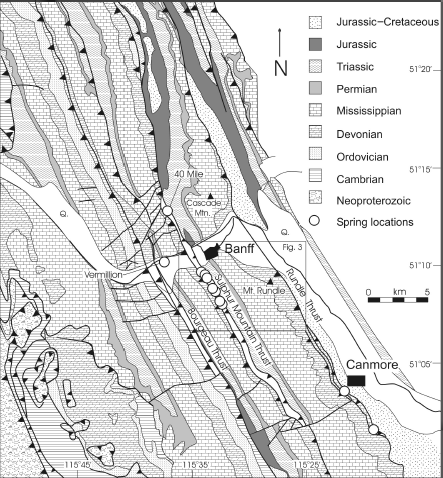
The sedimentary rock which forms the Rockies is about 1.5 billion years old and was largely deposited under ancient seas. These sediments, at that time on the west-coast continental shelf, were pushed to the northeast and inland. The flat layers bent into folds, broke into moving thrust sheets of rock, and were stacked upon each other. Where thrust sheets meet and ride over one another, a thrust fault is formed.
The Sulphur Mountain Thrust Fault, located slightly to the west of the town of Banff and running along the east-facing slope of Sulphur Mountain, is the reason for the thermal springs near the town.
It is also the ultimate reason for Banff National Park being created and allowed for the evolution of the Banff Springs Snail. Nowhere else in the world did the forces of geology and biology combine in this manner to allow the evolution of this unique species of snail, which is confined to the thermal springs found along the Sulphur Mountain Thrust Fault.
THE SPRINGS
HOW IT WORKS
All the thermal springs the Banff Spring Snail calls home are found along the Sulphur Mountain Thrust Fault, along the eastern facing slope of Sulphur Mountain. The highest elevational spring, the Upper Hot, is found at 1584 metres above sea level. The Middle Springs are at approximately 1500 metres elevation while the four thermal springs at the Cave and Basin National Historic Site are at 1400 metres above sea level.
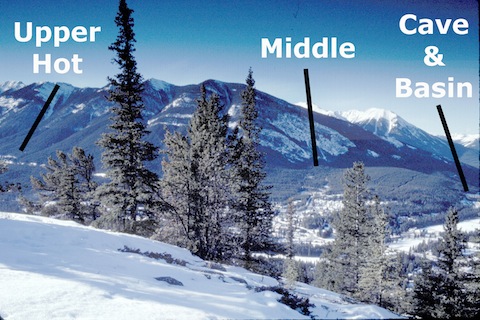
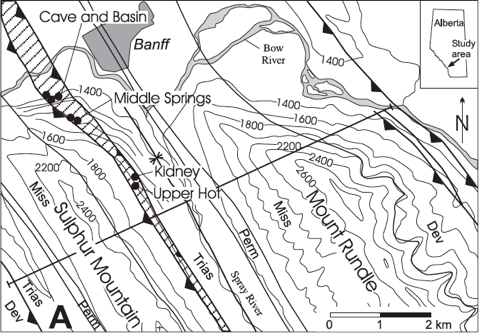
There are currently several theories explaining how the thermal springs on Sulphur Mountain work. In 1959, scientists thought that the water in the thermal springs on Sulphur Mountain came from Sundance Creek, which is in the valley west of Sulphur Mountain and contains the Borgeau Thrust. By 1972, another theory was proposed that it was actually rain and snow falling on Sulphur Mountain which supplied the springs with water. In the early 2000s, scientists collected water from the springs and at different elevations on the local mountains. By comparing the stable-isotopes in the water, they determined that water in the thermal springs on Sulphur Mountain originates as water falling on the local mountains at an elevation of approximately 2000 to 2100 metres. This helped confirm that the water in the springs is from locally deposited rain and snow but did not determine from which mountain.
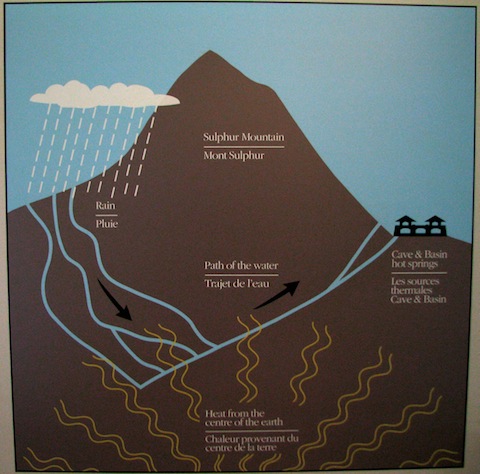
For the original rain and snow source theory to work, water would have to filter down cracks and across layers of rock because rocks are layered with an upward slope from east to west as one looks northward from the town of Banff. While there are still proponents of this theory, yet another theory is that rain and snow falling on neighbouring Rundle Mountain is the source of the water. Water infiltrating down through the rocks on Rundle Mountain would flow along the sloping layers of rock, not across the layers. Regardless of whether the water falls on Rundle or Sulphur, as it sinks into the earth, it begins to warm.
At some point, it reaches the Sulphur Mountain Thrust Fault, literally a pipeline to the surface. Scientists have calculated that water flowing from the springs on Sulphur Mountain comes from depths up to 3.2 km below the surface.
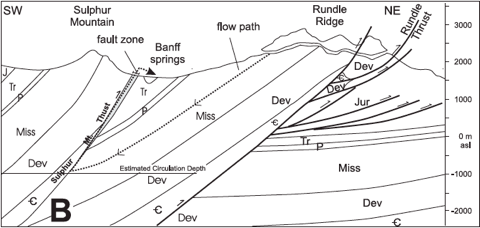
WATERFLOW
RECENT TROUBLE IN THE THERMAL SPRING FLOWS
Since the Banff Springs Snail Research and Recovery Program began in the fall of 1995, a new and troubling trend has emerged. Some of the thermal springs have been drying.

While it is normal for flow rates of thermal springs along Sulphur Mountain to decrease as underground reservoirs are depleted of water during late winter and early spring due to little melting and infiltration of water into the underlying rocks, the frequency of thermal spring drying has increased. The only historically recorded instance of any Sulphur Mountain thermal spring drying was at the Upper Hot, when no water flowed from 12 March through 11 May 1923.
Since 1996, the Upper Hot Spring has dried nearly every winter. Water has ceased flowing at the Upper Hot for durations from approximately one to 32 weeks. A lower than normal amount of precipitation in 1922 was the proposed cause of the 1923 flow stoppage. Similarly, below normal precipitation may be the cause of the recent flow anomalies. The lowest precipitation year on record (2001) was followed by the most extensive period of drying at the Upper Hot, and, for the first known instance, Kidney Spring also dried. While it is expected that the topographically highest springs along the Sulphur Mountain Thrust Fault will stop flowing first, inexplicably, the Upper Middle Springs dried for at least 12 weeks during the winter of 1995-1996 and Gord’s Pool Spring dried during the fall and winter of 2005-2006 and 2006-2007 when all other Sulphur Mountain thermal springs except the Upper Hot continued to flow
Timing and duration of thermal spring water flow stoppages, 1 January 1996 through 31 December 2010, Banff National Park. The line between the uprights indicates when no thermal spring water flowed as indicated by observation and temperature loggers. Monitoring of Gord’s did not begin until January 2001.
Scientists, including those on COSEWIC (Committee on the Status of Endangered Wildlife in Canada), the group which assesses the status of plants and animals in Canada, has determined that the cessation of water flow in the thermal springs is one of the biggest threats to the continued survival of the Banff Springs Snail. Furthermore, it is believed that climate change is the ultimate cause of the increased frequency of thermal springs drying.
THERMAL SPRINGS EXPLAINED
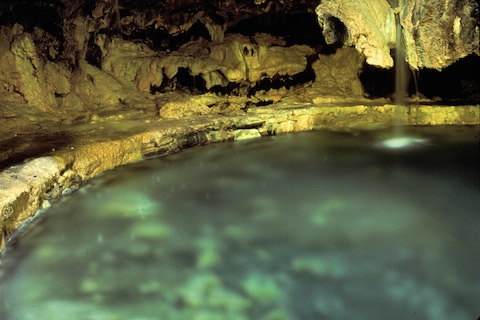
A thermal spring is simply a point of groundwater discharge whose water temperature exceeds the regional average air temperature. Traditionally, if the water is warmer than 5°C above the average annual temperature in an area, then it was called a thermal spring. In the Banff area—where the average annual temperature is -0.4°C—any groundwater that comes to the surface and doesn’t freeze could then be called a thermal spring!
A better definition used by some scientists is that a thermal spring is a point of groundwater discharge whose temperatures exceeds the regional average air temperature by more than 10°C. Other definitions for cold (0-9°C), cool (10-19°C), warm (20-29°C), and hot (>30°C) springs also are possible. Others divide them into warm (<37°C) and hot (37°C) springs, largely based on human body temperature.
If we use the latter definition, only the Upper Hot is truly a “hot spring” with Kidney Spring on the cusp of hot and warm and all the rest merely “warm”.
THERMAL SPRING ECOSYSTEMS
Thermal springs are extremely unique and fragile ecosystems with rare micro-climatic conditions created by and wholly dependent upon geothermal activity. The chemicals and minerals dissolved in the water and the associated cycles create a biologically harsh environment. Only a small group of plants and animals can withstand these conditions and they have to be uniquely adapted to be able to survive. They are also very sensitive to disturbance.
In 1928 an early thermal spring biologist Charles T. Brues described the many problems in trying to protect the natural contingent of flora and fauna that is the biodiversity of these unique ecosystems:
“From the naturalist’s standpoint and from that of the nature-lover as well it is distressing to record that all except the most inaccessible springs, or those included within the boundaries of National Parks, have been either converted to natatoria, sanatoria for arthritics, radium baths and the like, or have been diverted into irrigation ditches, sometimes with the aid of dynamite, to supply a few desolate ranches with water for cattle and alfalfa. For this reason the fauna and the flora of these thermal springs is destined soon to be wiped out over considerable areas by the advance of commercialism.”
Interestingly, this was stated two years after the Banff Springs Snail became known to science.
All the thermal springs on Sulphur Mountain, even though they are within a national park or national historic site, have been modified by development to varying degrees. Some have returned to more natural states, whereas others continue to be highly regulated.
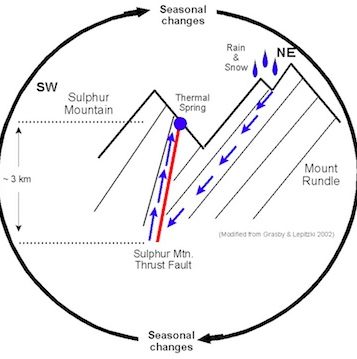
A series of virtual models have been made to help better understand how Banff’s thermal spring ecosystems operate. A most basic model for a typical Sulphur Mountain thermal spring shows water from rain and snow seeping into the earth to a depth of 2.5 to 3.2 km through cracks in the rock. The water becomes heated by the earth’s thermal gradient and pressurized. When it reaches the Sulphur Mountain Thrust Fault, it flows back to the surface. Seasonal changes due to frozen ground and no recharge during the winter and resumption of recharge with the spring thaw, result in seasonal changes in flow rates, water temperatures, and dissolved chemicals.
A large component of each thermal spring ecosystem is found underground. As the water passes through the rocks and becomes heated, gasses and minerals dissolve from the rocks and become suspended in the water. A subterranean bacterial community consumes and changes these dissolved materials. Sulphate-reducing bacteria (including Desulfovibrio, Clostridium, and the strict anaerobe Desulfotomaculum) can strip the oxygen from sulphate (SO4) for use in metabolic processes and create hydrogen sulphide (that rotten egg smell).

When the water reaches the surface in the origin pools of the thermal springs, it sustains another microbial community that in turn uses and converts the gasses and dissolved minerals. For example, the colourless, filamentous bacterium Beggiatoa, the white filamentous Thiothrix, the colony-forming Thiobacteria thiooxidans, and the purple bacteria can oxidize hydrogen sulphide to create elemental sulphur. Organic material such as leaves and woody debris (twigs, sticks, and logs) can contribute nutrients and structure to the biotic community within the spring’s origin.
Given sufficient oxygen and light, algae can grow and flourish. Water then flows out of the spring origin pool into the outflow stream. Both abiotic and biotic gradients are created as various biogeochemical constituents such as dissolved oxygen, hydrogen sulphide, carbon dioxide and water temperature change as the water flows downstream. And of course, overlaying these dynamic interactions are seasonal changes that occur within the various components of the thermal spring ecosystem.
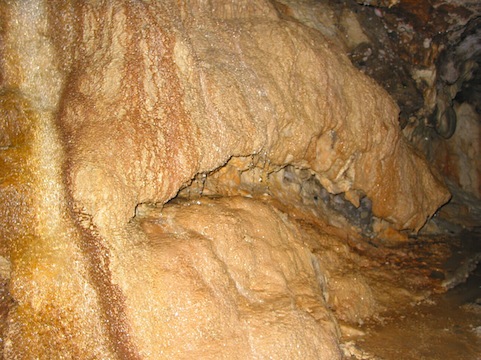
Another thing that happens once the water reaches the surface is that tufa (“TOO-fuh”), a type of soft rock, is formed. When thermal spring water that has been heated, pressurized, and laden with minerals bursts onto the surface, it releases dissolved carbon dioxide.
This reduces the ability of the water to hold the dissolved calcium and magnesium it has gathered by flowing through carbonate rocks such as limestone and dolomite. As a result, tiny crystals of calcite and gypsum grow.
Some species of mosses actually help the process of tufa formation, as does the agitation of the flowing water. This is the youngest rock in the Canadian Rockies. Just think! The youngest rocks are being formed before your very eyes from other rock that is millions of years old.
SEASONAL PICTURES
SEASONAL CHANGES NEAR BANFF’S THERMAL SPRINGS
The seasons bring magical changes to the thermal springs of Banff. The following section is a gallery showcasing the seasonal changes.

Frost on branches 
Frost and ice near thermal springs 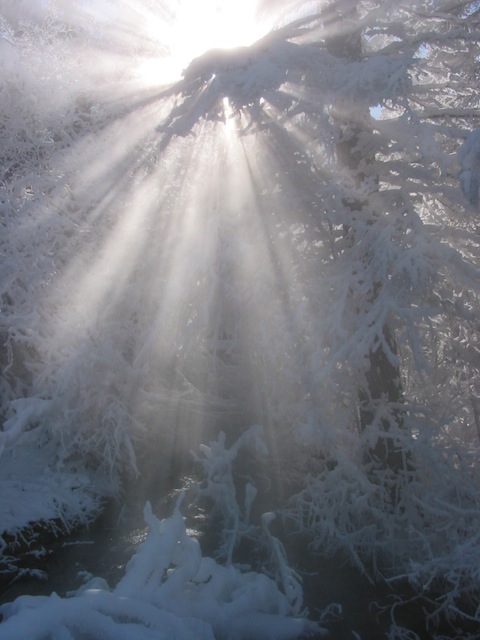

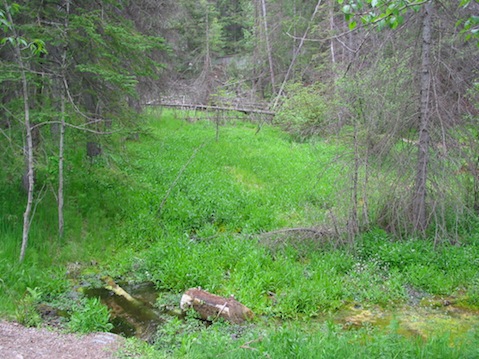
Spring thermal outflow area 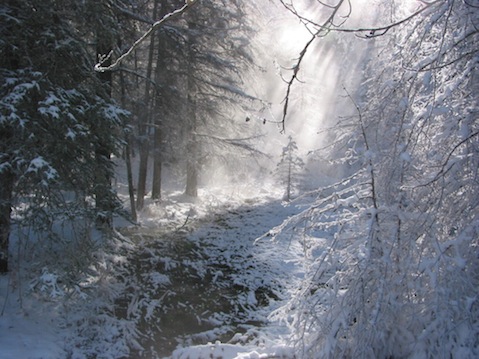
Winter thermal outflow area 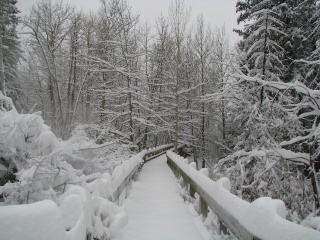
Winter and the end of summer along the lower boardwalk at the Cave and Basin National Historic Site. 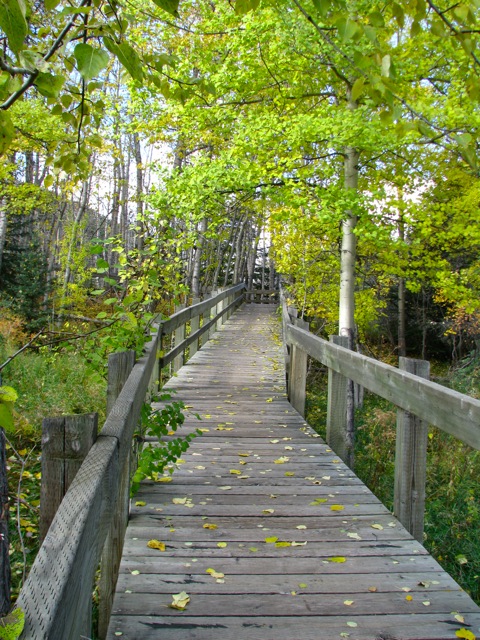
Summer lower boardwalk 
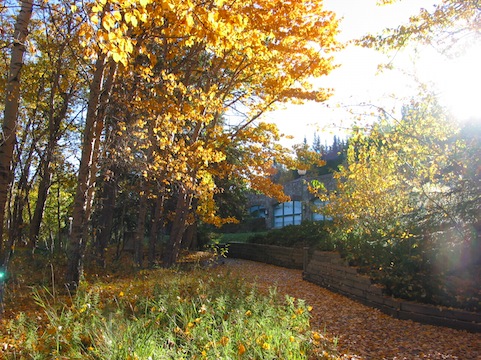
Aspens and poplars changing colour at the Cave and Basin National Historic Site. 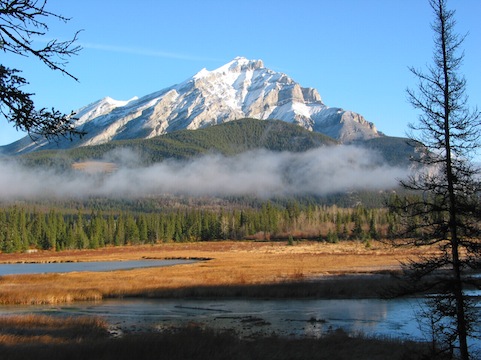
Spring Cave and Basin Marsh 
Fall Cave and Basin Marsh
SNAILS DIFFERENTIATED
BANFF SPRINGS SNAILS DIFFERENTIATED FROM OTHER SNAILS
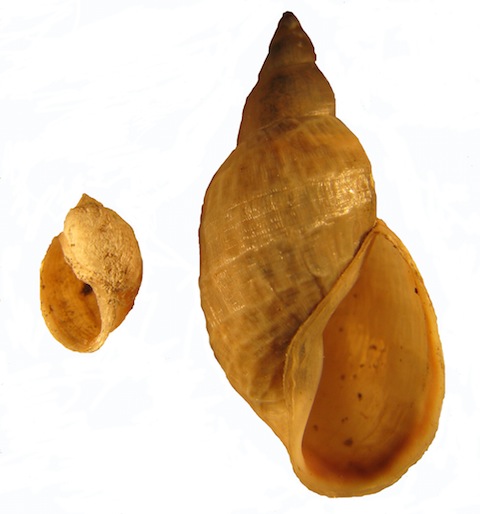
The Banff Springs Snail can easily be distinguished from other freshwater snails by examining its shell and where it lives. The Banff Springs Snail belongs to the Family Physidae. All species within Physidae have shells that coil to the left (sinistrally). All other families of freshwater snails in North America with a cone-shaped shell have shells that coil to the right (dextrally). By holding the shell with the aperture (the hole from which the snail’s body pokes out) towards you and the apex (tip) of the shell upwards, sinistrally coiling shells will have the aperture on the left.
In the thermal springs where they live, we have seen Banff Spring Snails that are light brown in colour as well as those that are nearly black. Many have a white coating on their shells which could be bacterial and algal growth or minerals deposited from the thermal spring water.
The shell of the Banff Springs Snail is shaped like a lemon seed and is about the same size as a lemon or orange seed or an un-popped kernel of popcorn. When baby snails hatch from their egg, they have a shell 0.8 mm long – about the size of the period at the end of the sentence. Most of the adult snails have shells around 5 mm but large individuals, with shells up to 11 mm long, are commonly found in the Basin Spring pool.
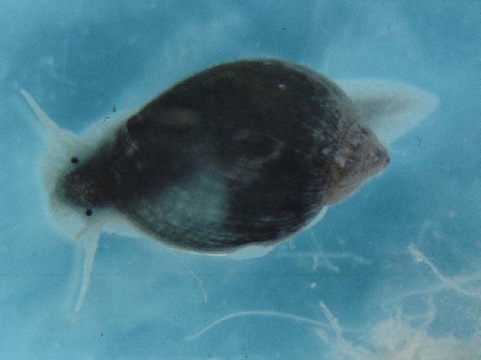
Banff Spring Snails have two long, thin tentacles on their head. At the base of each tentacle is a small black eye. Their foot is shaped like a tear-drop. When they are upside down, suspended on the water’s surface tension, you might be able to see waves of muscle contractions run down the foot – that’s how they move over rocks, sticks, or on the water’s surface – gliding along a path of clear mucus.
Scientists have studied the allozymes and mitochondrial DNA of Banff Spring Snails and have concluded that it is indeed a unique species, separate from all others in the world.
SNAIL EVOLUTION
HOW DID THE BANFF SPRINGS SNAIL EVOLVE?
Given the glacial history of the area near the town of Banff, the following simple theory was published in the scientific literature in 2001.
About 10,000 to 12,000 years ago, the last glaciers from the Wisconsin glaciation retreated from the area around the town of Banff. Left behind was a large glacial Lake Vermilion. Snails of the Family Physidae seem to like warm water. For example, near Edmonton, Alberta, the Common Tadpole Snail (Physella gyrina) can reproduce year-round in warm water produced from a coal-powered electrical generation plant. Within this ancient glacial lake lived the ancestors of the Banff Springs Snail, probably Physella gyrina. Some of these Tadpole Snails liked living in the warm water produced by the Cave and Basin thermal springs, which flowed into the ancient lake. The shoreline of the ancient lake was at approximately the same elevation as the Cave and Basin Springs. Over time, as the lake level dropped, the snails became reproductively isolated from their ancestors and a new species – the Banff Springs Snail – evolved.
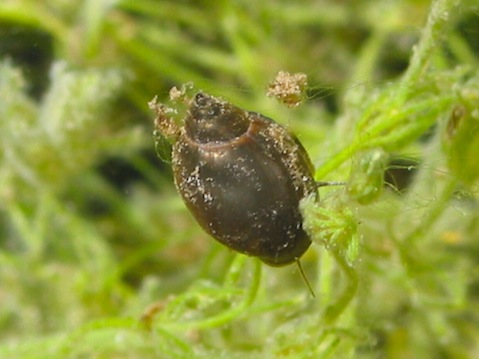
This theory will have to be slightly modified. More recent studies have shown that the tufa rock that forms the Cave Spring is only between 3,200 and 5,300 years old. Consequently, the Banff Springs Snail did not arise from its ancestors 10,000 to 12,000 years ago, but much more recently. A similar age has been determined for the Miette Springs in Jasper National Park. They are believed to have begun flowing and started depositing tufa about 4,500 years ago, under cool and moist habitat conditions coincident with higher ground-water levels of the Neoglacial period.
This period followed the Hypsithermal, a multiphased warm period between 9,000 and 5,000 years ago, when the climate was warmer and dryer than average and immediately followed the retreat of the glaciers. It is feasible that the thermal springs on Sulphur Mountain had little or no flow during the prolonged dry period of the mid-Holocene Hypsithermal.
Re-examining the glacial history near the town of Banff reveals the following details:
About 13,000 years ago, the glaciers had retreated back into the mountains. However, a glacier still plugged the Bow Valley and lay overtop the current townsite of Banff, although the top of Tunnel Mountain was now exposed. Glacial Lake Vermilion, at 1432 m elevation, extended northwards from the eastern extent of the glacier and up the Cascade River. Water may have flowed out the Glacial Lake through the current path of the Cascade River. Between 13,000 and 11,000 years ago, the glacier continued to retreat westward up the Bow Valley. The toe of the glacier was about halfway between the western edge of Third Vermilion Lake and the Highway 1A turnoff. To the east of the glacier lay Proglacial Lake Vermilion at 1395 m elevation (proglacial means near-glacial). This water body extended to Bow Falls on the Bow River to the southeast and towards Cascade Ponds to the northeast. It may have drained both through the Cascade and Bow rivers. Sometime between 10,000 and 8,000 years ago, the lake shrank some more and was now at an elevation of 1383 m, draining only through the Bow River over Bow Falls (currently, the cool springs at Third Vermilion Lake sit at an elevation of 1381 m). The waterbody was now called Holocene Lake Vermilion. The northeastern edge of the lake was somewhere near the road to the Banff Industrial Compound and trailer drop-off. By about 6,600 years ago, the lake continued to shrink and its eastern edge was somewhere near the Banff C.P.R. train station. But, the Hypsithermal period was coming to a close.
As Holocene Lake Vermilion continued to shrink and then was slowly in-filled by sediments deposited by the Bow River and alluvial fans of tributaries, the thermal springs along the flank of Sulphur Mountain sprang to life during the cool and moist conditions following the Hypsithermal. The ancestors of the Banff Springs Snail congregated near the warm water inflows flowing from the Cave and Basin Springs into the Cave and Basin Marsh and Bow River. Over time, perhaps as they slowly made their way upstream, they became reproductively isolated. We do currently see Banff Springs Snails actively crawling upstream to get closer to the thermal spring origin pools.
Alternatively, perhaps a bird transported an ancestral snail directly into the Basin Spring pool. Ducks and other shorebirds have occasionally been observed in the Basin Spring and this mode of transport has been documented in the scientific literature. Adding additional credence to the bird transport theory and in contrast to the snail-crawling upstream theory is that while one can easily observe the Common Tadpole Snail off the fish observation platform at the Cave and Basin Marsh, the middle sections of the thermal spring outflow streams at the Cave and Basin are devoid of physid snails.
It seems that bird transport may be a better theory and would also need to be invoked to explain the snail’s historic and current distribution.
SNAIL REPRODUCTION
HOW DOES THE BANFF SPRINGS SNAIL REPRODUCE?
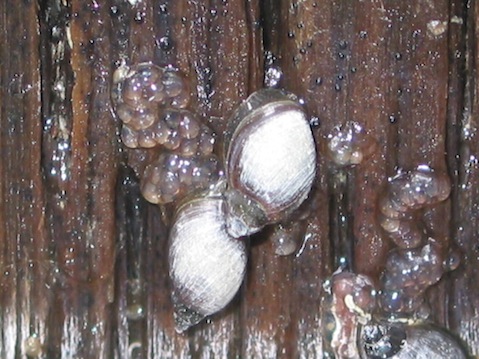
Each Banff Springs Snail has both male and female reproductive organs – they are hermaphrodites. In theory, a single snail could therefore reproduce on its own. While this is a common type of reproduction in freshwater snails and allows some species to quickly increase in numbers, there are consequences to this life style. Scientists have found that when snails reproduce on their own, their offspring are not as fit or healthy as are those offspring which have two parents.
The Banff Springs Snail lays eggs, as do most other kinds of snails. In other physid snails, 10 to 12°C is usually the minimum trigger for the snails to start reproducing but because the Banff Springs Snail lives in thermal springs, they can reproduce throughout the year and we have seen the clear, fat, banana-shaped egg capsules year-round in some springs. Because the egg capsules are clear and only about 5 mm long by 2 mm wide, they are difficult to see.
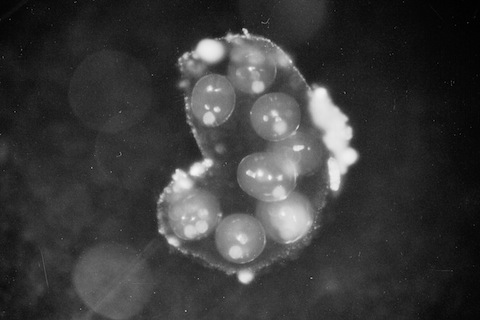
They are usually found right at the air-water interface attached to the floating mat of bacteria and algae, or sticks, and other objects. We have even seen them attached to other snail shells. They most likely require atmospheric oxygen to develop, given the low levels of dissolved oxygen in the thermal spring water. Based on observations in aquaria, Banff Spring Snail egg capsules contain around 12 individual eggs. It takes about 6 days for the eggs to develop and tiny, miniature snails with shell lengths less than 1 mm to hatch.
Once they grow to about 3 mm in shell length, they can then begin laying their own eggs. In aquaria where the snails were being fed, they reached a reproductive size in about 9 weeks. In the wild, we expect growth rates to be slower. We also suspect they only live for about a year or so, because when we put adult-sized snails into aquaria, they lived for another 10 or 11 months.
ENDANGERED SPECIES
WHY IS THE BANFF SPRINGS SNAIL ENDANGERED?
The Committee on the Status of Endangered Wildlife in Canada (COSEWIC) is responsible for determining the national status of Canada’s plants and animals. When the federal government passed the Species at Risk Act (SARA) in the summer of 2002, the mandate of COSEWIC was legally established. COSEWIC uses the best available scientific as well as Aboriginal and Community Knowledge to assess the probability of Canada’s native birds, mammals, reptiles, amphibians, fishes, arthropods, vascular plants, mosses, lichens and molluscs of going extinct – disappearing forever from the earth – or being extirpated – disappearing from the wild in Canada.
COSEWIC uses five quantitative criteria to assess the status of the species as presented in a written status report: (1) decline in Total Number of Mature Individuals (2) Small Distribution Range and Decline or Fluctuation (3) Small and Declining Number of Mature Individuals (4) Very Small or Restricted Total Population (5) Quantitative Analysis.
Status can range from extinct to not at risk.
When COSEWIC first examined the Banff Springs Snail in 1997, they determined that the species was Threatened. At that time, Threatened meant that it was a species likely to become endangered if limiting factors were not reversed. Also at that time, it was the first living mollusc to be assessed in Canada by COSEWIC.
In May 2000, COSEWIC adopted quantitative criteria more similar to that used by the IUCN (International Union for the Conservation of Nature) and re-examined the status of the Banff Spring Snail. They uplisted the Banff Springs Snail to Endangered – a species facing imminent extirpation or extinction. The reason for designation was that it was a “Highly specialized species with extremely limited distribution subject to human disturbance and extreme fluctuations in population size.”
When SARA passed in 2002, many of the animals and plants that were assessed by COSEWIC as being Extirpated, Endangered, Threatened, and Special Concern, including the Endangered Banff Springs Snail, were automatically listed and legally protected under SARA.

According to SARA, COSEWIC must re-assess each species once every 10 years. In 2008, the status of Endangered was confirmed by COSEWIC. The Banff Springs Snail is endangered because it meets the following quantitative criteria: B1ac(iv)+2ac(iv). The official reason for designation can be found on this screenshot of the COSEWIC Assessment Summary
Details on COSEWIC and the criteria they use can be found here. Status reports and other documents on the recovery of species can be found here.
FLUCTUATION
FLUCTUATION OF BANFF SPRINGS SNAILS
One of the reasons the Banff Springs Snail is Endangered is because snail populations fluctuate yearly by more than one order of magnitude (10 fold). Highest numbers of snails are observed in the dead of winter – typically from January through February. As winter comes to an end, snail populations crash and are at the lowest over the summer – typically from May through August. After the end of summer, their numbers then begin to increase.

Population lows of 30 and 43 snails have been observed in different springs since January 1996, when intensive monitoring began. When populations are this low, any chance event, or human disturbance, could result in the extirpation of that population. An act as simple as picking up a stick lying half in the thermal spring water and tossing it for a dog to chase could drastically reduce or eliminate a snail population at this time, if most of the spring’s snail population is found on that stick.
The causes of the annual population fluctuations are uncertain but are most likely related to food supply and / or the seasonal dynamics of the thermal spring ecosystems.
ECOLOGICAL ROLE
THE ECOLOGICAL ROLE OF BANFF SPRINGS SNAILS
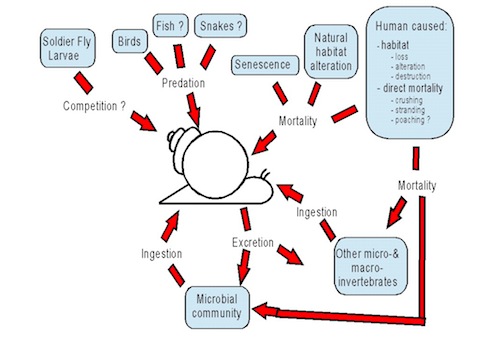
To better understand the ecological role of the Banff Springs Snail in thermal spring ecosystems, a simple model was constructed. The primary ecological role of the snail is as a grazer, where it eats the microbial community. The microbial community is composed of bacteria and algae that grow on the various substrates within the thermal spring pools and outflow streams. These substrates include sticks, rocks, leaves, other vegetation, and the concrete-lined pool edges.
The snails also have been observed to eat material floating on the water’s surface. The snails may also inadvertently eat other, smaller microscopic animals in the springs. In turn, the snails process their food and their excretion is most likely used by other organisms, including the microbial community and community of other micro and macro-organisms in the springs.
The snails can die a number of ways.
Birds most likely eat the snails. It has been shown by scientists that waterfowl, such as ducks, actively seek out snails, especially in the spring, to gain the calcium from the snail shells for their own egg production. The earliest returning robins are commonly observed near the thermal springs in Banff. Garter snakes, which have been observed to be active at the Cave and Basin even during the winter, could prey on Banff Spring Snails as could the introduced Mosquito Fish (Gambusia affinis). However there appears to be little overlap between the snail and the Mosquito Fish as the fish require higher levels of dissolved oxygen, typically found where snail numbers are lower. Competition may be occurring between the snails and Soldier Fly larvae as both eat the microbial community. Typically, Soldier Fly larvae are at their maximum size in the spring, just as the microbial community begins to be affected by seasonal changes in the water chemistry of the springs and snail populations are declining.
Snails can also die from old age or when their habitat becomes altered naturally. A herd of elk walking through the thermal spring outflow stream can alter the stream’s course, stranding some snails but potentially creating new habitat for others.
One of the causes of snail death is also one of the easiest to control – the death of snails caused by humans through direct mortality or damage or destruction of the snail’s habitat or its food sources.
THREATS
THREATS TO BANFF SPRINGS SNAILS
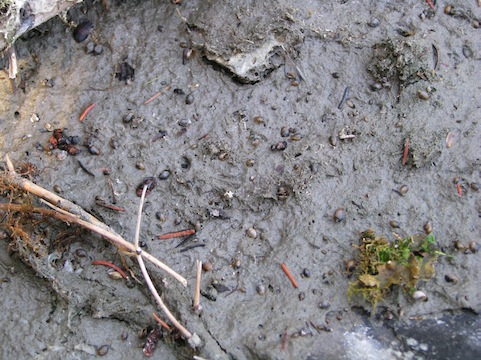
A number of threats have been identified for the Banff Springs Snail and its habitat. Details can be found in both the COSEWIC status report and Recovery Strategy and Action Plan available at http://www.sararegistry.gc.ca.
From the most to least serious the threats are:
- water flow stoppages
- flow reductions and fluctuations (natural and human-caused)
- thermal water flow redirections (natural and human-caused)
- limited or low-quality habitat
- humans soaking and swimming
- population lows and genetic inbreeding
- human-caused habitat trampling and local disturbance
- human limb-dipping (touching the water with hands or feet)
- stochastic events (such as storms)
- predation, competition, collecting, and twitch-ups
Of these 10 categories of threats, humans are involved in six, or seven, if one considers water flow stoppages due to climate change being caused by humans.
THERMAL SPRINGS
THERE ARE MORE THAN JUST SNAILS IN THE THERMAL SPRINGS
The thermal springs on Sulphur Mountain are home to more than just the Banff Spring Snail. Over the years, scientists have identified other invertebrates as well as plants that call the Banff springs home. Here are a few of these organisms.
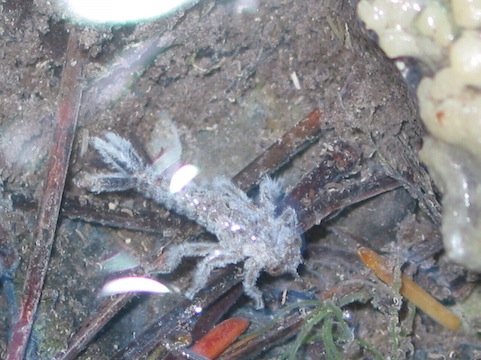
A nymph of the Vivid Dancer damselfly (Argia vivida). There seems to be a coating of microbial growth on this individual. 
A group of Soldier Fly (Family Stratiomyidae) larvae. These larvae may be competitors with Banff Spring Snails for food. 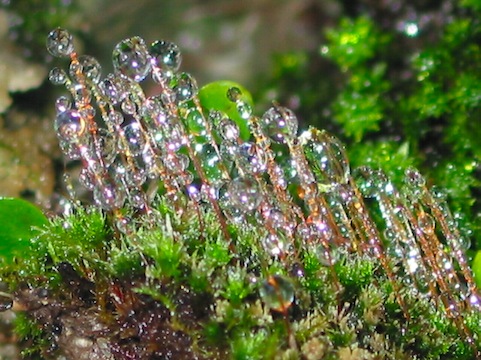
Water droplets on mosses found in the splash zone along a thermal spring outflow stream. A number of rare mosses and bryophytes are found at Banff’s thermal springs. 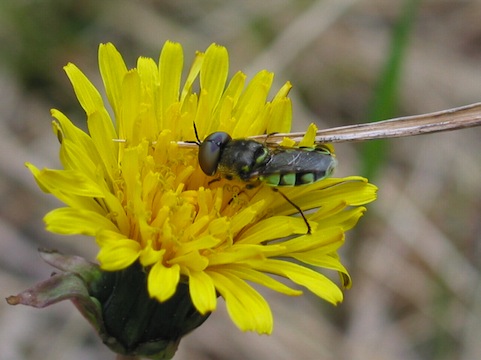
An adult Soldier Fly (Family Stratiomyidae). 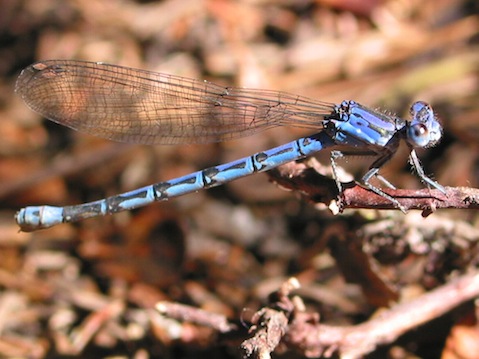
An adult Vivid Dancer damselfly (Argia vivida). In Alberta, this species is at the northern edge of its range and only found in Alberta at the thermal springs in Banff. It is also found near springs in British Columbia. The Arthropods Species Specialist Subcommittee of COSEWIC lists this species in the highest category of species yet to be assessed. 
A Rat-tailed maggot larva (Family Syrphidae, flower flies) in the Basin Spring pool. It breathes atmospheric air through its long tubular tail.
HOW YOU CAN HELP
The biggest thing visitors can do to help protect the Banff Springs Snail and their thermal spring habitat is to comply with protection actions already in place.
- Do not disturb their habitat.
- Stay out of closed areas.
- Do not touch the thermal spring water.
Report others who are not complying with the law to staff at the Cave and Basin if that is where you see the infractions occurring or contact the Banff Warden Office directly at 403-762-1470.
WHY YOU SHOULD CARE
You should care because all life forms have an inherent right to life. Some people may argue that humans have the inalienable right to determine which species live or die, which species are useful and which are unnecessary. However, humans are but one species, which at present seem to be a controlling force. We definitely do have the technology and means of destroying vast tracks of nature.
Back in 1953, Aldo Leopold wrote the following:
“The outstanding scientific discovery of the twentieth century is not television, or radio, but rather the complexity of the land organism. Only those who know the most about it can appreciate how little is known about it. The last word in ignorance is the man who says of an animal or plant: ‘What good is it?’ If the land mechanism as a whole is good, then every part is good, whether we understand it or not. If the biota, in the course of aeons, has built something we like but do not understand, then who but a fool would discard seemingly useless parts? To keep every cog and wheel is the first precaution of intelligent tinkering.”
It really comes down to biodiversity. The United Nations declared the year 2010 as the International Year of Biodiversity. This follows the 1992 United Nations Convention on the Conservation of Biological Diversity which Canada, as well as many nations around the world, signed. This was a commitment by the government and people of Canada to help preserve the Earth’s variety of life. Both SARA and the National Parks Act are just means to ensure that the people of Canada live up to their international commitments.
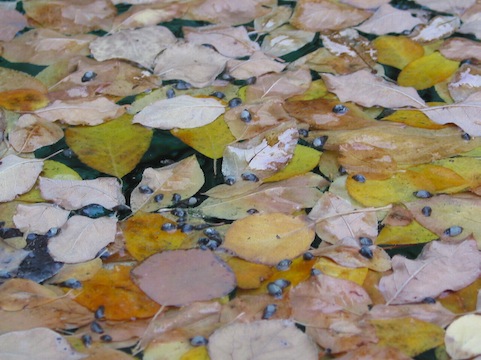
The preamble to the Canadian Species at Risk Act emphasizes the commitment to biodiversity: “the Government of Canada is committed to conserving biological diversity”. Further, SARA specifically states that “Canada’s protected areas, especially national parks, are vital to the protection and recovery of species at risk”. Because the Banff Springs Snail is found only within Banff National Park, the full complement of provisions for species protection and recovery within SARA are automatically applicable to the snail. This is in addition to provisions under the National Parks Act that protect species within national parks. The National Parks Act also mandates Parks Canada to restore or maintain ecological integrity.
Up to February 2011, the Banff Springs Snail was the only species in Canada for which all the steps required for the recovery of a SARA listed species had been completed: the Recovery Strategy and an Action Plan were approved by the Government of Canada in 2007. In addition, Critical Habitat – “habitat that is necessary for the survival or recovery of a listed wildlife species” – has been delineated and established in law. In February 2011, the Recovery Strategy and Action Plan for Bolander’s Quillwort (Isoetes bolanderi), a fern-like plant confined in Canada to a few small lakes and ponds in Waterton Lakes National Park, became the second SARA listed species to have full protection under SARA.
Therefore, another reason why people should care about the Banff Springs Snail is because it is the law – under both the National Parks Act and the Species at Risk Act – to protect the snail and its habitat.